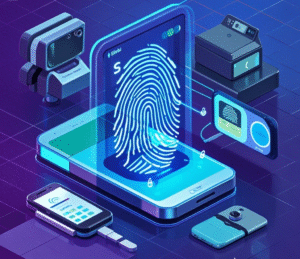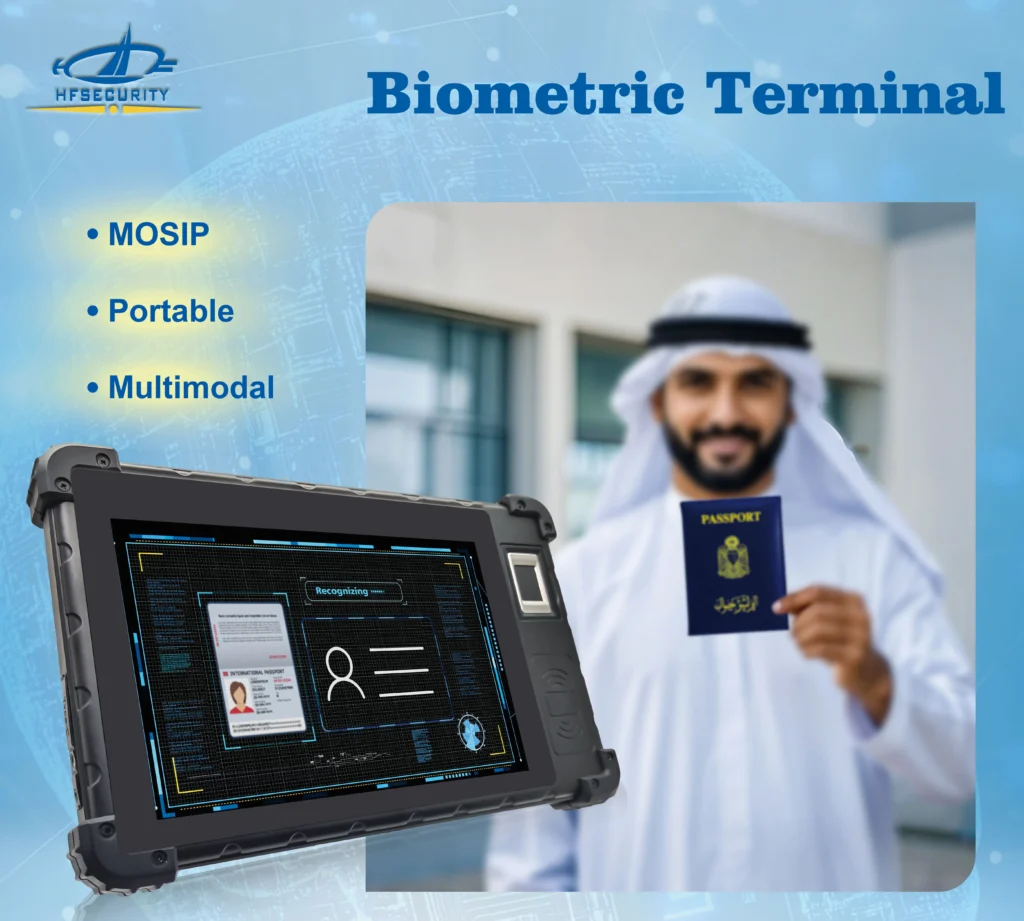In the modern digital age, biometric authentication methods have become essential tools for secure identity verification. These technologies use unique biological traits to confirm a person’s identity—offering greater accuracy, convenience, and security compared to traditional passwords or cards.

This article explores the five main types of biometric authentication methods and provides guidance on how to choose the most suitable option based on your specific use case.
Fingerprint Recognition
Facial Recognition
Palmprint Recognition
Palm Vein Recognition
Iris Recognition
1.Fingerprint Recognition
Fingerprint recognition is one of the most widely used biometric authentication methods. It works by analyzing the ridges and valleys of an individual’s fingerprint to create a unique digital signature. This pattern is then compared to stored templates for identity verification.
Thanks to its high accuracy, speed, and ease of use, fingerprint recognition is commonly used in access control systems, mobile devices, banking security, and law enforcement. Modern fingerprint scanners often include liveness detection technology to prevent spoofing attempts using fake or cloned prints. The technology is cost-effective and has a low false acceptance rate (FAR), making it suitable for both large-scale public applications and enterprise-level identity management.
Common Applications:
Smartphone security
Employee attendance systems
Banking and ATM authentication
Border control and identity management
2. Facial Recognition
Facial recognition identifies users by analyzing facial features such as the distance between the eyes, nose shape, and jawline using AI algorithms and camera input. These unique facial characteristics are converted into a mathematical representation, often called a facial template, which is then matched against a database to verify or identify an individual.
This contactless and user-friendly technology has gained widespread adoption in access control systems, time attendance devices, mobile phone security, airport immigration checkpoints, and smart city infrastructure. Advanced systems now support liveness detection to prevent spoofing using photos, videos, or 3D masks, ensuring a higher level of security. Facial recognition is especially effective in high-traffic environments, where speed and hygiene are priorities, and it can function even when users are wearing masks or glasses—thanks to infrared and depth-sensing cameras combined with machine learning models.
Common Applications:
Public security and law enforcement
Smart access control systems
Retail customer analytics
Travel and airport check-ins
3. Palmprint Recognition
Palmprint recognition uses the unique patterns on the surface of the palm—such as lines, wrinkles, and ridges—to identify individuals. These features are stable over time and differ significantly from person to person, making them highly reliable for biometric authentication.
Compared to fingerprints, palmprints offer a larger surface area, allowing the system to capture more data points, which enhances recognition accuracy. Palmprint scanners typically use optical or contactless sensors, and with the aid of AI-based image processing, they can quickly extract features and match them against a stored database.
Common Applications:
Secure facility access
Healthcare identity verification
Civil registration systems
4. Palm Vein Recognition
Palm vein authentication scans the unique vein pattern beneath the skin using near-infrared (NIR) light, which is absorbed by the deoxygenated hemoglobin in the blood, allowing the system to clearly map the vein layout. Since the vascular pattern lies beneath the surface of the skin, it is extremely difficult to replicate or alter, making palm vein recognition one of the most secure biometric technologies available today.
Unlike surface-based biometrics such as fingerprints or facial features, palm vein patterns are non-intrusive and unaffected by external conditions like dirt, cuts, or skin abrasions. The authentication process is contactless, promoting hygiene and reducing sensor wear. In addition, the false acceptance rate (FAR) and false rejection rate (FRR) are extremely low, ensuring high reliability in both identification and verification modes.
Common Applications:
High-security financial services
Hospital patient identification
Government access systems
5. Iris Recognition
Iris recognition uses a high-resolution camera to capture the unique pattern of the colored part of the eye (iris), which remains stable over time and is unique to each individual—even between identical twins. The system analyzes intricate details such as rings, furrows, freckles, and crypts within the iris to create a digital template used for identity verification.
The system works by illuminating the eye with infrared light, which enhances the contrast of the iris pattern and reduces the influence of eye color or ambient lighting. The captured image is then transformed into a digital template and compared with stored records in a secure database.
Common Applications:
Airport and border control
Military and government sectors
Secure healthcare access
Related products
How to Choose the Right Biometric Authentication Method
| Criteria | Recommended Method | Hygiene concerns (contactless) | Facial or palm vein recognition |
|---|---|
| High-security requirements | Iris or palm vein recognition |
| Cost-effectiveness | Fingerprint or palmprint recognition |
| Ease of deployment | Fingerprint or facial recognition |
| Non-intrusive experience | Facial or palmprint recognition |
For environments such as hospitals or airports, contactless biometric solutions are preferred. In contrast, factories or offices may opt for fingerprint devices due to lower costs.
Other Biometric Authentication Methods (Optional Consideration)
In addition to the main five, there are other biometric modalities gaining popularity:
Voice Recognition: Uses vocal patterns to verify identity, ideal for call centers.
Retina Scan: Extremely accurate but more invasive, mainly used in high-security military environments.
Behavioral Biometrics: Includes typing rhythm, gait, and touchscreen behavior—often used in fraud detection.
The Role of Biometric Authentication in Modern Security Systems
As digital threats evolve, biometric authentication methods play a critical role in strengthening identity verification systems. Unlike traditional passwords or PINs, biometrics rely on unique physical traits, making them more difficult to forge or steal. This increased security is why biometric solutions are now essential in sectors like banking, healthcare, transportation, and government operations.
Furthermore, multi-factor authentication systems often combine biometric data with NFC cards or QR codes to build robust identity frameworks that ensure only authorized individuals gain access.
Future Trends in Biometric Authentication Technologies
With continuous advancements in AI, machine learning, and sensor technology, the future of biometric authentication methods is promising. Upcoming trends include:
AI-powered behavioral biometrics that monitor user patterns in real time
3D facial recognition for higher accuracy and liveness detection
On-device biometric processing for enhanced privacy
Wearable biometric sensors integrated into smartwatches and glasses
As these technologies evolve, we can expect broader adoption in industries requiring both convenience and security, driving the next generation of identity verification solutions.
Conclusion
With threats to digital security on the rise, selecting the right biometric authentication method is more important than ever. Whether you’re managing employee access or protecting sensitive data, the right biometric system will enhance your organization’s security while providing a seamless user experience.
FAQ
Palm vein and iris recognition are considered the most secure due to their difficulty to replicate and internal nature.
Yes, but they must be implemented with proper data protection, encryption, and user consent protocols.
Yes, many biometric systems offer offline verification using stored templates and can sync data when reconnected.
Most systems offer multi-factor authentication or a fallback option like PIN, card, or password.
Yes, but modern facial recognition systems use infrared and AI to enhance performance under poor lighting and even partial obstructions.






